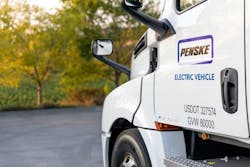The movement to electrify passenger vehicles is getting a lot of press. But electrification is coming to the commercial vehicle market, too.
According to ACT Research, commercial electric vehicles - or what it calls CEVs - will make up nearly 40% of the Class 4 through Class 8 truck population in the United States and Canada within the next 15 years.
ACT Research also predicts that by 2040, nearly 320,000 out of the projected 750,000 total commercial vehicles operating in North America will be CEVs.
I recently caught up with ACT Research Analyst Jim Meil, who discussed the factors that are driving this expansion, which types of trucks make a good "fit" for electrification, why CEVs appeal to certain fleets and more.
MTD: ACT indicates that commercial electric vehicles will reach nearly 40% share of the Class 4 through Class 8 truck market by 2035. What is driving this growth?
Meil: The major factor driving the share gain is the rapidly falling costs of batteries. We project a decline of about one-third in the next 10 years, which will enhance the business case for EVs. In addition, policy moves that will tilt the playing field to the advantage of electrification (emissions requirements nationally and in states and provinces - California, most notably) will push some of that share gain.
MTD: What class of trucks is seeing the biggest growth in electric models?
Meil: We believe Class 6 through Class 7 will turn out to lead in both share gain and volume, with upwards of 70% share take by 2035 to 2040, translating into close to 130,000 Class 6 through Class 7 vehicles at the far reach of our ... 20-year horizon. Many of the aspects that pave the way for electrification fit well with Class 6 through Class 7 applications - just to name two: pickup and delivery in urban areas (and) school buses.
MTD: Why are fleets adopting commercial EVs? What's the compelling proposition?
Meil: First and foremost, fuel savings as efficient electric engines will beat their internal combustion engine counterparts in this dimension in many cases. Second, the simpler drive train of an electric vehicle will result in service, maintenance and uptime benefits compared to the more complicated internal combustion engine counterpart.
MTD: What are the barriers to more widespread electric truck acceptance by fleets and how will those obstacles diminish over the next several years?
Meil: Right now, part of the issue is product availability. Getting early production models out of the factory and into dealerships has lagged personal vehicles. The commercial vehicle marketplace is driven more by P&L and ROI financial factors that the personal market, where consumer choice, taste, status and trendiness come into play. Also, commercial vehicle operators tend not to be on the leading edge. They don't like to be first movers.
Earlier this month, MTD talked representatives from various truck tire manufacturers, who commented on challenges that electric trucks pose to truck tire design and construction. You can read that article here.
More recently, we talked with an executive from Daimler Trucks North America about progress that company is making on the electric truck front.
The passenger vehicle car parc will likely electrify sooner than commercial trucks. But we will continue to track the electrification of the commercial truck market, as developments there could have a significant impact on your business, particular if truck tires are your bread-and-butter.
About the Author
Mike Manges
Editor
Mike Manges is Modern Tire Dealer’s editor. A 28-year tire industry veteran, he is a three-time International Automotive Media Association Award winner, holds a Gold Award from the Association of Automotive Publication Editors and was named a finalist for the prestigious Jesse H. Neal Award, the Pulitzer Prize of business-to-business media, in 2024. He also was named Endeavor Business Media's Editor of the Year in 2024. Mike has traveled the world in pursuit of stories that will help independent tire dealers move their businesses forward. Before rejoining MTD in 2019, he held corporate communications positions at two Fortune 500 companies and served as MTD’s senior editor from 2000 to 2010.

